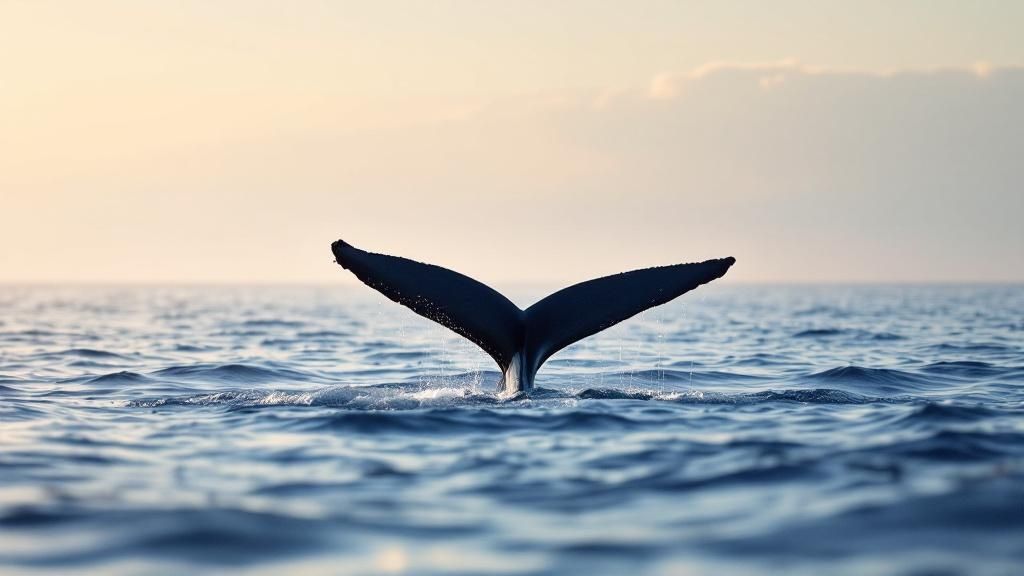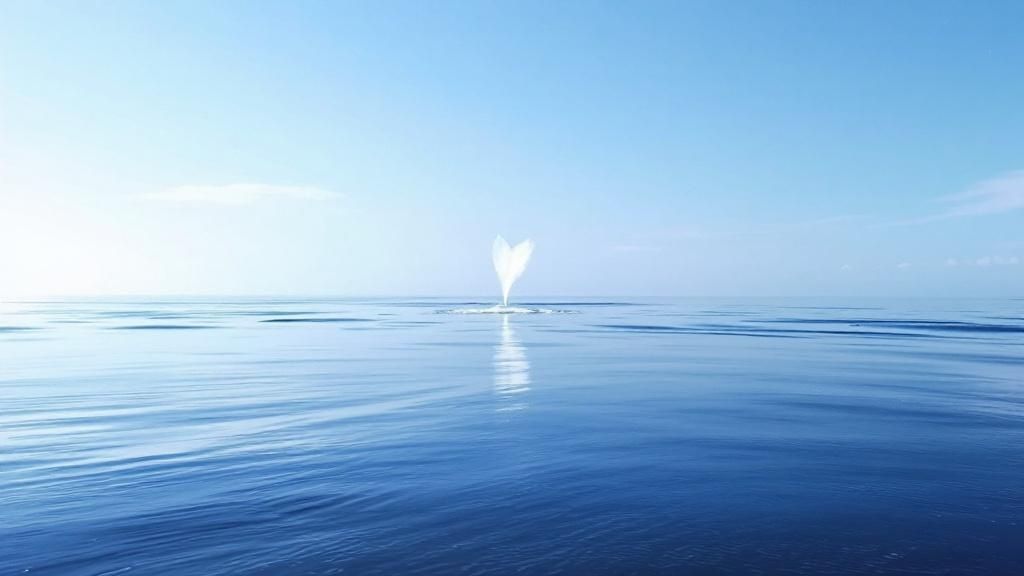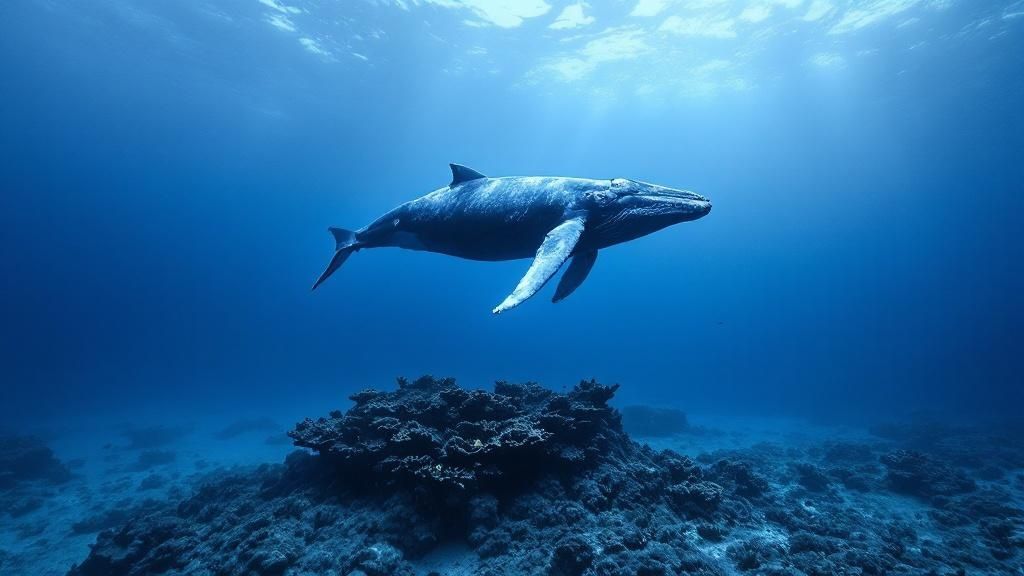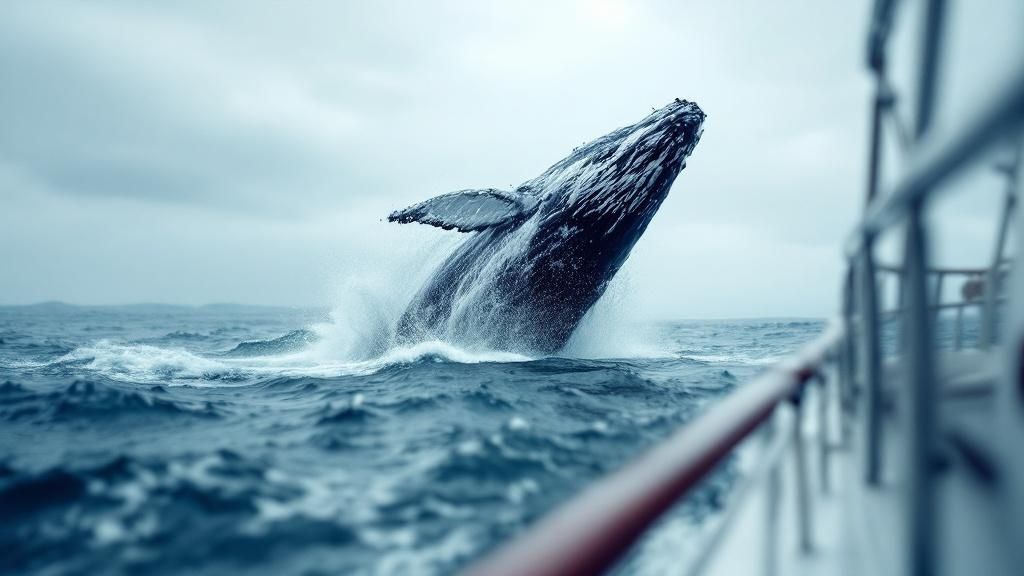Whale Watching Big Island: The Ultimate Guide to Incredible Encounters

There are few things in this world that can prepare you for the sight of a 40-ton humpback whale launching itself out of the ocean. It's a moment that just sticks with you. If you want to experience that for yourself, the best whale watching on the Big Island happens from December to April, with the absolute peak activity lighting up the waters in January and February, especially along the stunning Kohala Coast.
This guide is all about getting you ready for an adventure with these incredible ocean travelers.
Your Guide to Big Island Whale Watching
Every single winter, the warm, sheltered waters around the Big Island turn into the grand stage for one of nature's most mind-blowing shows. Thousands of North Pacific humpback whales make a grueling 3,000-mile swim from their frigid feeding grounds in Alaska, all the way down to Hawaii's calm, shallow bays. It's an incredible migration driven by the most basic needs: to mate, give birth, and nurse their newborn calves in a safe, warm nursery.

Of course, who you go with can make or break the experience. We're a bit biased, but as Hawaii's top-rated and most-reviewed snorkel company, we at Kona Snorkel Trips live and breathe this stuff. Our whole mission is to make sure you have a memorable and responsible day out on the water.
Think of this guide as your complete playbook for planning the perfect whale watching Big Island trip. We’re going to cover everything you need to know.
Why the Big Island Is a Premier Destination
So what makes this place so special for whales? The Big Island, and its western coastline in particular, has the perfect recipe for a whale-watching paradise. The deep offshore waters run right up against shallower coastal shelves, creating the exact conditions humpbacks love.
The Kohala Coast is hands-down the hotspot. It consistently pulls in two to three times more whale sightings than any other spot on the island, making it the undisputed champion for anyone hoping to see some action.
This isn't just a hunch. Long-term data from the Sanctuary Ocean Count, a volunteer effort running since 1996, proves it year after year. The numbers show that January and February are the peak months for whale activity right here. By March, sightings usually drop by about half as the whales start heading back north. You can geek out on even more Big Island whale watching trends from years of observational data on lovebigisland.com.
What This Guide Covers
We’ve put this together to help you plan an extraordinary trip from start to finish. By the time you're done, you'll have a real appreciation for these gentle giants and feel totally prepared for what's in store.
- The Epic Migration: We'll dive into the incredible journey these whales make and why Hawaii is their final destination.
- Best Times to Visit: Pinpoint the absolute best weeks of the year to maximize your chances of seeing breaches, tail slaps, and maybe even a calf.
- Top Viewing Locations: Discover the best spots for watching from both the shore and out on the water.
- Choosing Your Tour: Get the inside scoop on how to pick the right boat tour that fits your style and budget.
- Responsible Practices: Learn how to be a respectful observer and help protect these amazing animals for years to come.
The Epic Journey of Hawaii's Humpback Whales
Every winter, something magical happens in the deep blue waters off the Big Island. It's the final stop on an incredible migration, a 3,000-mile pilgrimage made by thousands of North Pacific humpback whales.
Think of it as the most important road trip of their lives. After a summer spent feasting on krill and small fish in the chilly, nutrient-rich waters of Alaska, they point themselves south. They aren't coming for the food—in fact, they fast for most of their time here—they're coming for the warm, calm, and protected environment that only Hawaii can provide.

This massive journey is hardwired into them, driven by the powerful instinct to create new life. The Big Island's sheltered bays and shallow coastal waters are the perfect nursery, offering a safe haven from predators like killer whales that prefer colder, deeper seas. Here, they can put all their energy into raising the next generation.
A Sanctuary for New Life
The whole reason for this epic swim comes down to three things: mating, birthing, and nursing. The warm water temperature is absolutely critical for newborn calves, who are born with just a thin layer of blubber. They simply wouldn't survive the freezing temperatures of their Alaskan feeding grounds.
For months, these gentle giants are busy with complex courtship rituals. You'll often spot males competing for a female's attention in what we call "competition pods," which leads to some of the most dramatic surface action you'll ever witness while whale watching on the Big Island. After a gestation period of almost a year, pregnant females come right back to these same waters to give birth.
This annual migration is a story of survival and renewal. The whales trade the abundance of their feeding grounds for the safety of Hawaii's aquatic cradle, ensuring the continuation of their species.
The calves spend their first few months of life right here, nursing on their mother's incredibly rich milk. They need to bulk up and get strong for their own first trip north to Alaska. It's a remarkable cycle of life playing out right off our coast. To learn more about this amazing spectacle, check out our other guides for your whale watching Big Island adventure: Whale Watching Big Island.
A Remarkable Comeback Story
Seeing these magnificent creatures today is a privilege we almost lost forever. Humpback whales were once hunted to the brink of extinction by decades of commercial whaling. But thanks to worldwide conservation efforts, they have made an incredible recovery.
The North Pacific population, in particular, has seen a huge rebound. Today, experts estimate the population to be around 26,000 individuals, with a massive portion of them making that annual trip to the Hawaiian Islands. The creation of the Hawaiian Humpback Whale National Marine Sanctuary was a game-changer, helping to coordinate the programs that allow these giants to thrive.
This conservation success makes every single sighting feel even more special. It's a powerful reminder of nature's resilience and our shared responsibility to protect it. When you're out on the water, you're not just a spectator; you're witnessing the beautiful result of decades of hard work. That comeback story adds a profound layer of meaning to every breach and tail slap you see in Hawaiian waters.
When to Go Whale Watching on the Big Island
Timing your whale watching trip on the Big Island is a bit like planning to catch the perfect wave—it’s all about knowing when and where the action will be. While you can spot humpbacks here from late November all the way through April, what you'll see changes dramatically from month to month. To really hit the jackpot, you want to aim for the heart of the season.
The first scouts, usually energetic adult males, start showing up in late November and early December. Think of them as the early arrivals for a massive, months-long party. They’ve just made the long haul from Alaska, and their arrival kicks off the season with powerful displays of athleticism as they re-establish their dominance.
As the weeks roll on, more and more whales pour into Hawaiian waters. The population swells, building to an incredible crescendo. If your goal is to see the absolute most whales and the most jaw-dropping behaviors, you'll want to book your trip for January or February.
The Peak Season: January and February
There's no question about it: January and February are the absolute best months for whale watching on the Big Island. During this window, the waters off the Kona and Kohala coasts are buzzing with activity. This is when the highest concentration of humpbacks has arrived, turning the ocean into a stage for nature's greatest show.
This is also prime time for mating rituals, which means you’re much more likely to witness breathtaking behaviors like:
- Competitive Pods: It's common to see groups of powerful males chasing after a single female. This often leads to dramatic, high-energy clashes at the surface that you have to see to believe.
- Breaching: There’s nothing quite like watching a 40-ton whale launch its entire body out of the water. Breaches are most frequent during this peak period.
- Singing Males: On a calm day, tour boats equipped with hydrophones can often pick up the complex, haunting songs of male humpbacks. These melodies are sung to attract mates and can travel for miles underwater.
Long-term volunteer counts consistently show that January and February produce the highest number of sightings. In fact, some data shows that the number of whales spotted in the early morning can be 50% higher than just a few hours later. For a deeper dive into the season's patterns, check out our detailed Big Island whale watching season guide.
Understanding the Shoulder Months
While January and February get all the glory, the "shoulder" months of December, March, and April offer their own unique and rewarding experiences. The vibe of the season shifts, giving you a chance to see a different side of the humpback's time in Hawaii.
By the time March and early April roll around, the dynamic changes again. The frantic energy of the competitive pods dies down as many males start their long migration back to the chilly waters of Alaska. These later weeks become the nursery of the sea, dominated by mothers and their newborn calves.
This period offers a more serene but equally profound whale watching experience. You’ll see mothers teaching their calves essential skills, like how to breach and slap their tails, all in the relative safety of Hawaii's warm waters.
The pace is gentler, but the sight of a calf playfully shadowing its mother is one of the most heartwarming moments you can witness in the wild. By the end of April, almost all the whales have departed, leaving the ocean quiet until they return next winter.
To help you get a clearer picture of the season, we've put together a simple month-by-month guide.
Big Island Whale Watching Season Calendar
Here's a quick look at what you can generally expect to see each month, from the first arrivals to the last goodbyes.
| Month | Whale Activity Level | Commonly Observed Behaviors |
|---|---|---|
| December | Increasing | First arrivals, mainly adult males. Breaching and tail slaps are common as they announce their presence. |
| January | Peak | High concentration of whales. Competitive pods, singing males, and constant surface activity. |
| February | Peak | The absolute highest number of whales. Great chance to see active pods alongside new mothers with their calves. |
| March | Decreasing | Mothers and calves become the main show. Males begin migrating north. Calves are often seen practicing breaches. |
| April | Low | Last departures. Sightings are less frequent but often feature mothers and calves lingering in the warm waters. |
Ultimately, no matter when you come during the season, you’re in for a treat. Each month offers a unique glimpse into the lives of these magnificent animals.
Where to Find the Best Whale Watching
Figuring out when to go whale watching is only half the puzzle. You also need to know where to look. Luckily, the Big Island serves up incredible viewing opportunities, whether you're standing on its rugged coastline or cruising out on the water.
But you have to remember, not all coastlines are created equal in the eyes of a humpback whale.
The Undisputed Whale Watching Hotspot: The Kohala Coast
If there's one place you're almost guaranteed to see action, it's the Kohala Coast. This stretch along the island's northwestern side is a certified whale magnet, and for a good reason. The underwater landscape here is tailor-made for them. Deep ocean channels run right up next to shallow, protected bays, giving mothers and their new calves the perfect mix of security and space to roam.
Think of it as the ideal whale neighborhood: quiet, safe, and close to everything they need. It's this unique geography that leads to the Kohala Coast logging two to three times more sightings than anywhere else on the island. It’s not just luck; it's prime real estate for these gentle giants.
Top Spots for Shoreline Viewing
You don’t always need a boat to witness the magic. With a little patience, a good pair of binoculars, and the right vantage point, you can catch an amazing show right from the shore. The island's elevated bluffs and scenic pull-offs are fantastic platforms for spotting spouts, breaches, and tail slaps from a distance.
Here are a few of the best places to post up for some land-based whale watching:
- Puukohola Heiau National Historic Site: The name literally means "hill of the whale" in Hawaiian, which tells you everything you need to know. This historic site offers sweeping, elevated views over the ocean, making it a premier spot for watching pods cruise by.
- Lapakahi State Historical Park: A bit further north, this park's high bluffs give you a commanding perspective over the water. Just a heads-up, it’s a hot and dry area, so bring plenty of water and sun protection. The views are well worth it.
- Scenic Lookouts: Keep your eyes peeled for the many unnamed pull-offs and overlooks along the Queen Ka'ahumanu Highway (Hwy 19) and the Akoni Pule Highway (Hwy 270). These spots are often quiet and offer completely uninterrupted views of the ocean.
The real key to seeing whales from land is patience. Find a comfortable spot, scan the horizon for that tell-tale "blow" from a whale's spout, and then lock your eyes on that area. Where there’s one, there are often more.
Getting an Up-Close View on a Boat Tour
Watching from shore is a peaceful way to spend an afternoon, but absolutely nothing compares to the up-close, personal encounters you can have on a boat tour. Most tours leave from hubs like Kona and take you right into the heart of the action, giving you an eye-level perspective that is simply unforgettable.
A professionally guided tour is about more than just getting closer, though. The marine naturalists onboard add a whole new layer to the experience. They can tell you what all the different behaviors mean, answer your questions, and even drop a hydrophone into the water so you can hear the males' haunting songs.
By federal law, all boats must stay at least 100 yards away to make sure the whales are respected and undisturbed.
The recent volunteer whale counts just go to show how active these waters are. During the 2025 coordinated count, volunteers spotted a whopping 1,947 humpback whales across the main islands. A big chunk of those—263 sightings—were recorded right here around Hawai'i Island. This annual census confirms that the early morning hours are an especially great time for sightings. You can dig into more of the data from the annual whale count on mauinow.com.
For the ultimate whale watching adventure, try doing both—spend some time watching from shore and then head out on a boat tour to get the best of both worlds.
Choosing The Right Whale Watching Tour
Picking the right tour for your whale watching adventure on the Big Island is probably the most important decision you'll make. The boat you're on completely shapes your experience out on the water, dictating everything from how comfortable you are to how up-close-and-personal the sightings feel. It really sets the stage for the whole day, so it pays to know your options before you book.

You’ve got everything from large, steady catamarans that are perfect for families to zippy Zodiac-style rafts built for thrill-seekers. Each one offers a totally different perspective. Bigger boats give you a smoother ride and more amenities, but the smaller, more nimble vessels can often get you an exciting, eye-level view of the action when it happens.
Comparing Your Tour Options
So, how do you decide? Let’s break down the most common types of tours. Think about what's most important to you. Are you looking for a stable platform to snap amazing photos, or are you after a fast-paced ride that puts you right at the water's edge? Each has its perks and its trade-offs.
This quick comparison should help you match a tour style to what you and your group are looking for.
Comparing Big Island Whale Watching Tour Types
Here’s a look at the most common boat tour options to help you choose the best fit for your adventure.
| Tour Type | Best For | Pros | Cons |
|---|---|---|---|
| Large Catamaran | Families, comfort-seekers, photographers | Stable ride, onboard amenities (restrooms, snacks), shaded areas, elevated viewing decks. | Larger groups, less intimate experience, may not get as close as smaller boats. |
| Zodiac / Raft | Thrill-seekers, adventurous travelers | Fast and exciting, low to the water for eye-level views, can cover more area quickly. | Bumpy ride, no amenities, high exposure to sun and spray, not suitable for all ages or abilities. |
| Private Charter | Small groups, special occasions, customized trips | Ultimate flexibility, personalized itinerary, intimate setting with direct access to the captain/guide. | Most expensive option, booking in advance is crucial. |
As you weigh your options, don't forget that some operators offer incredible combo trips. For anyone hoping to pack more into their day, there are fantastic combined snorkeling and whale watching experiences that give you the best of both worlds—above and below the waves.
What Makes a Great Tour Operator
Beyond the boat itself, the quality of the operator is what turns a good trip into a truly unforgettable one. A great company does more than just find whales; they give you a deeper understanding of what you're seeing and always put the well-being of the animals first.
Here’s what to look for in a top-notch tour:
- Onboard Marine Naturalist: Having an expert on the boat is a total game-changer. A naturalist can explain whale behaviors as they happen, answer all your questions, and share incredible insights into the lives of these gentle giants.
- Commitment to Guidelines: Responsible operators are serious about following federal viewing guidelines, which means staying at least 100 yards away from the whales. Showing this respect for their space is essential for their safety.
- Educational Focus: The best tours are basically floating classrooms. They’ll drop a hydrophone in the water so you can hear the haunting songs of the male humpbacks and provide educational info that deepens your appreciation for the entire marine ecosystem.
Choosing a tour operator with a strong focus on conservation means your trip does more than create memories—it supports the protection of the very animals you’ve come to see.
This dedication to education and conservation ensures your whale watching trip is not only a blast but also meaningful. You’ll leave with a much deeper connection to the ocean and a lasting sense of wonder for Hawaii’s majestic humpback whales.
How to Practice Responsible Whale Watching
Seeing a humpback whale breach in its natural habitat is one of those moments that just takes your breath away. It's powerful, it's humbling, and it's an incredible privilege. But that privilege comes with a shared responsibility to protect these amazing animals.
Practicing responsible whale watching is actually pretty simple, but it’s absolutely crucial for making sure these gentle giants keep returning to Hawaiian waters for generations to come. It's all about turning that incredible feeling you get from seeing them into a positive impact.
Keep Your Distance
The single most important rule is also the easiest one to remember: keep your distance.
Federal law is crystal clear on this. Every single vessel—from big tour boats all the way down to kayaks and paddleboards—has to stay at least 100 yards away from humpback whales. That’s the length of a football field. This isn't just a friendly suggestion; it’s a critical buffer zone that gives the whales the space they need to rest, nurse their calves, and just be whales without feeling stressed or threatened.
Any reputable tour operator worth their salt knows these rules by heart and acts as a guardian on the water. They understand that a whale’s well-being is way more important than getting a few feet closer for a selfie.
Choosing an Eco-Conscious Tour
Your choice of a tour operator is probably the biggest way you can vote with your wallet for conservation. A truly ethical company doesn’t just follow the bare minimum rules; they actively promote marine stewardship. They see themselves as educators first, not just entertainers.
So, how do you spot one? Look for operators who:
- Have Marine Naturalists on Board: Having an expert on the boat completely changes the trip. They can tell you what you're seeing, explain the behaviors, and give you a much deeper appreciation for the local ecosystem.
- Respect Speed Limits: A responsible captain will slow way down in areas where whales are known to hang out. This is non-negotiable for avoiding tragic collisions.
- Never Circle the Whales: Good operators will position the boat parallel to the whales, giving them a clear path to go wherever they please. The last thing you want to do is make them feel cornered or trapped.
A responsible tour is an investment in the future of whale watching. When you support companies that put the animals first, you're helping raise the bar for the whole industry and ensuring these encounters can continue for years to come.
Your Role as a Whale-Friendly Visitor
Your actions matter, both on and off the boat. Beyond just picking the right tour, there are small but powerful things you can do to protect the marine environment these whales call their temporary home.
One of the easiest habits to get into is using reef-safe sunscreen. The chemicals in a lot of traditional sunscreens can wash off in the water and do serious damage to our delicate coral reefs, which are the foundation of the entire marine food web. It's a tiny change for you that has a massive ripple effect.
For a deeper dive into the best times to see the whales and how to plan your trip, be sure to check out our complete guide to whale season in Hawaii. By being a mindful visitor, you help keep the magic of whale watching on the Big Island alive for everyone.
Common Questions About Big Island Whale Watching
Even after you've planned everything out, a few last-minute questions always seem to pop up before a whale watching Big Island trip. Getting those details ironed out beforehand is the key to a smooth, stress-free day on the water. We get these questions all the time, so let's tackle them head-on.

This final section is all about those practical details, giving you the confidence to squeeze every bit of magic out of your whale watch.
What Kind of Whale Behaviors Can I Expect to See?
You've got a shot at seeing some truly incredible whale acrobatics. The one everyone hopes for is the breach, where a 40-ton whale launches its entire body out of the water. It’s a moment you’ll never, ever forget.
But there's plenty more to watch for. Here are a few other common behaviors you might see:
- Tail Slap: An explosive slap of the whale's massive tail on the water's surface that sounds like a cannon shot.
- Pectoral Fin Slap: This is when a whale rolls onto its side and repeatedly slaps its long fin—which can be up to 15 feet long—against the ocean.
- Spyhop: A curious whale will sometimes poke its head straight out of the water, almost like it's trying to get a better look at you.
If you're really lucky, you might stumble upon a "competition pod," where several males are actively competing for a female's attention. And nothing compares to hearing the haunting, complex songs of the males through an underwater hydrophone, which many tour boats have on board.
What Should I Bring on a Whale Watching Tour?
Coming prepared makes all the difference between a good trip and a great one. You'll want to pack a few essentials so you can focus on the show without being uncomfortable.
Your must-haves are reef-safe sunscreen, a good hat, and a pair of polarized sunglasses to cut through the powerful glare on the water. It’s always a good idea to wear layers; even on a hot day, the wind out on the ocean can feel chilly, so a light jacket or windbreaker is perfect. A camera with a zoom lens is fantastic, but don't forget to put it down and just soak it all in. Binoculars are also a game-changer for spotting blows and breaches way off in the distance.
Is a Morning or Afternoon Tour Better?
Honestly, you can't go wrong with either. Both morning and afternoon trips offer fantastic viewing opportunities, but there are some subtle differences.
Morning tours often have the advantage of calmer seas. The winds tend to be lighter, which means a smoother ride and sometimes makes it a little easier to spot the whales from a distance.
Afternoons are great, too, and can occasionally be less crowded. Plus, the late-afternoon "golden hour" light is absolutely stunning for photos. The truth is, the whales are active all day long, so the absolute best tour is simply the one that fits your schedule. The most important thing is making sure you're here during peak season.
For an unforgettable journey into the world of Hawaii's marine life, trust the experts at Kona Snorkel Trips. As the Big Island's highest-rated snorkel and tour company, we are dedicated to providing safe, respectful, and awe-inspiring ocean adventures. Book your tour today and create memories that will last a lifetime.
